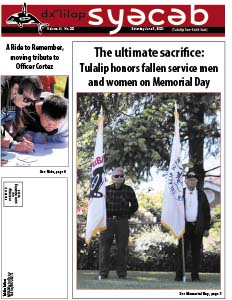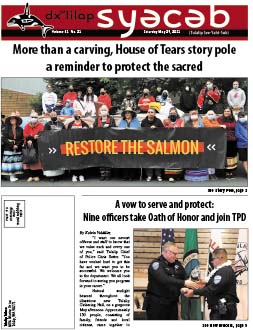
Category: Tulalip News
June 5, 2021 syəcəb
stəgʷad (Salmonberry) season
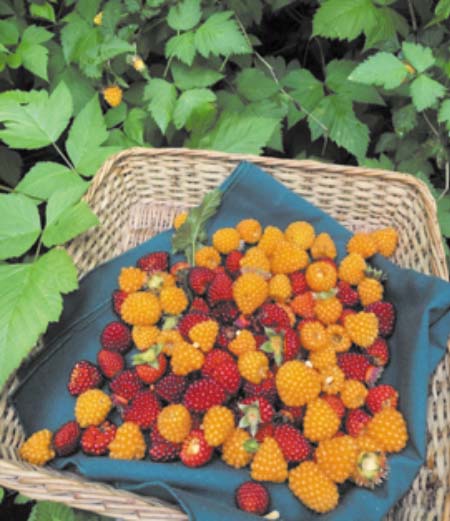
Submitted by AnneCherise Jensen
stəgʷad (Salmonberries) play an important role in the culture, traditions and way of life of many Native Americans tribes – all the way from the west coast of Northern California, through Canada, and up to Alaska. Traditionally, the Salmonberry is named after Coast Salish Native Americans fondness for eating the berries with both salmon & salmon roe. Salmonberries also play a significance in similarity in how they look a lot like salmon roe, with their orangey-pink color of the berries. The berries were generally eaten fresh, due to their high water content and difficulty to preserve – and considered a delicacy in Native American culture. To this day, salmonberries have also been known to be made into jams and jellies, and can be preserved by freezing.
Salmonberries are the earliest berry to ripen and harvest in the Spring, harvested anywhere as early May to late July depending on the elevation of the berry shrubs. Lower elevation bushes will be the first to ripen, while higher elevation will ripen later in summer. Salmonberry bushes tend to have fewer thorns than some other berry species, and typically make for a smooth and pleasant harvest. Salmonberry colors vary from dark red, to pink, to bright orange. Each color tends to have its own unique flavor, with the vibrant red known to be slightly sweeter and the orange berries slightly more tart. They are a native northwest plant, growing in abundance in marshy, wetland and forested areas with nutrient rich, unbothered soils.
Salmonberries are an extremely nutrient dense and healthy food, some may also even refer to it as a superfood. Salmonberries are packed with vitamins, minerals and antioxidants that help nourish & replenish the body. They are especially high in vitamin C, vitamin A, vitamin E, Manganese, fiber and rich phytonutrients. Here is the nutrient information on one serving (1 cup) of salmonberries. As you can see, salmonberries are an excellent source of vitamins and minerals and are a great traditional food to add to your diet this time of year.
Serving Size: 8 oz or 1 cup
Nutrient % Daily Value (% Daily Value is the percentage of the Daily Value for each nutrient in a serving of the food. The Daily Values are recommendation amounts of nutrients for individuals to consume each day for optimal health outcomes )
- Fiber 15%
- Folate 10%
- Riboflavin 11%
- Phosphorus 9%
- Magnesium 9%
- Manganese 108%
- Vitamin A 22%
- Vitamin B6 14%
- Vitamin C 23%
- Vitamin E 16%
- Vitamin K 34%

stəgʷad Salmonberry Jam recipe
Salmonberry jam is a great way to preserve and utilize a large salmonberry harvest. The jam can either be made within 24 hours after harvest, or you can freeze them and make the jam at a later time. The sugar to berry ratio is as follows; Measure the berries to find out how many cups you have and put them in a saucepan. Measure out 2/3 cup of sugar for every 1 cup of berries. For example, for three cups of berries, you will need 2 cups of sugar. For every 3 cups of berries, you will need a half a cup of lemon juice.
Ingredients:
- 3 cups Salmon Berries
- 2 cups sugar
- 1/2 cup lemon juice
Directions:
- Rinse salmon berries in light lukewarm water.
- Add salmonberries, sugar and lemon juice into a large saucepan. Your ingredient measurements may vary depending on how many berries you plan to process.
- Turn the saucepan on medium heat and mix all ingredients together. Allow to warm up the mixture for about 15 minutes.
- Once ingredients start to warm up, use a potato masher to slowly break down the berries into smaller pieces.
- Once berries are broken down – turn the heat up and allow the jam mixture to boil anywhere from 5-8 minutes. This will create a thicker consistency and the volume of the mixture should reduce to half.
- After boiling, turn on low and allow to simmer for an additional 10-15 minutes.
- Test the thickness of the jam by taking out a teaspoon and allowing it to cool.
- Once you get a thickness you like – remove from stove top and place into your favorite container.
- Refrigerate. Should last approx a year in the refrigerator.
- Enjoy salmonberry jam on some whole wheat toast, protein pancakes, or some vanilla frozen yogurt!
**This material was funded by USDA’s Supplemental Nutrition Assistance Program – SNAP. This institution is an equal opportunity provider.
Sources:
https://www.nutritionvalue.org/Salmonberries
http://nativeplantspnw.com/salmonberry-rubus-spectabilis/
The ultimate sacrifice: Tulalip honors fallen service men and women on Memorial Day
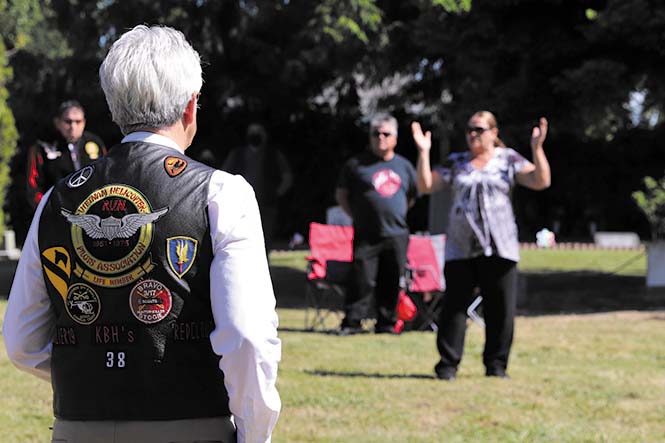
By Kalvin Valdillez, Tulalip News
“I come from a line of many people who have served in the military,” said Tulalip Veteran Angela Davis. “I want to thank everyone for being here and supporting our veterans and those who have gone before us. I was told by a commander one time that less than 1% of our population chooses to serve in the military. But when it comes to Native Americans we actually have a higher percentage; Native Americans serve at a higher rate than any other population. I want to thank our Native American veterans and remember the ones who have fallen.”
Two special Memorial Day services were held at Tulalip to honor the brave men and women who fought to defend this Nation’s freedom and are no longer with us. Mini U.S. flags and flower arrangements decorated the final resting place of over 200 tribal members who honorably served during their lifetime, at both the Priest Point and Mission Beach cemeteries. Families from near and far traveled to the reservation to witness the ceremonies and pay their respects on a gorgeous morning during the last day of May.
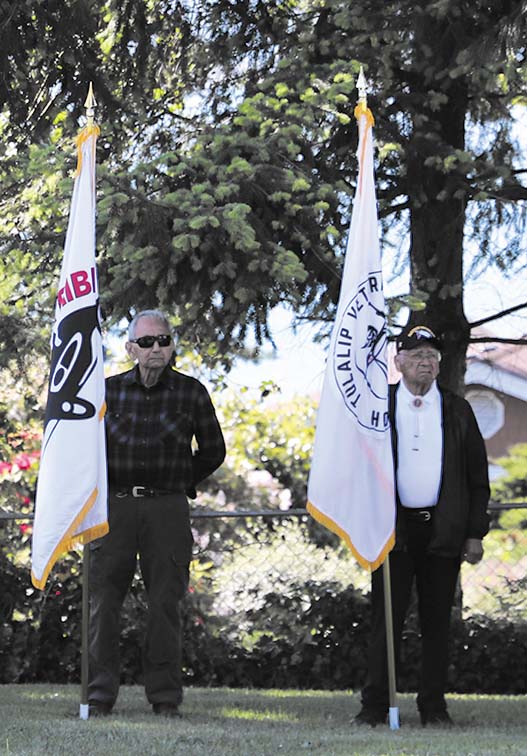
Sticking to tradition, Vietnam Veteran and Tulalip BOD Mel Sheldon took up hosting responsibilities, providing good natured humor as well as sincere recollections and sentiments throughout the day of remembrance.
Mel shared, “Across the Nation, as we gather to remember those who made the ultimate sacrifice, those that died for our country, we remember our Tribal members who died fighting from Tulalip. Special thanks to our brothers and sisters, they didn’t ask for it but they made the sacrifice. Today we are also remembering Stan [Jones], our former chairman for many years, every year he was here with the veterans.”
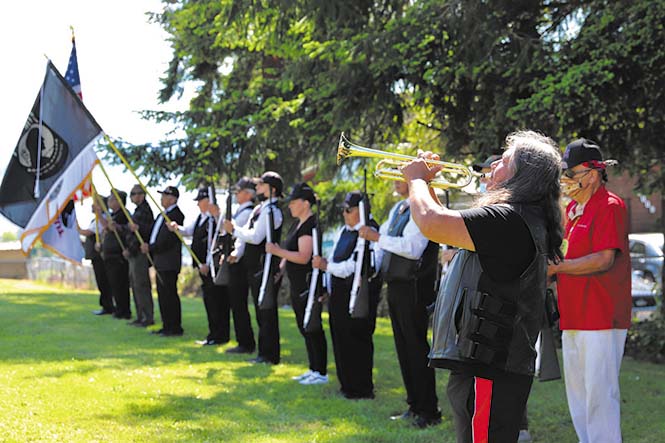
Teri Gobin, Tulalip Chairwoman and daughter of Stan Jones added, “I think about what you have to go through being in the service. I think about my father and the stories he told me. I want to say thank you to all who came out to honor those who made the ultimate sacrifice, those who served to protect us, and their families who stood beside them.”
As this Nation’s original caretakers, defending this land may have a more significant meaning to tribal members across the country. It maybe the reason why there are 31,000 active Native American men and women serving today, and why there’s over 140,000 living veterans who are Indigenous, according to the Department of Defense. And as Angela stated, Natives serve at a higher rate than any other demographic, five times the national average to be exact.
Throughout the many years that Tulalip celebrated Memorial Day with its membership, Tulalip Veteran Cy Hatch III held the honor of reading the names of each tribal member who served and died for this country during roll call. However, the 2020 ceremonies would serve as the last time that Cy spoke the names of his fallen military brethren aloud as he officially passed the torch to Sara Andres this year.
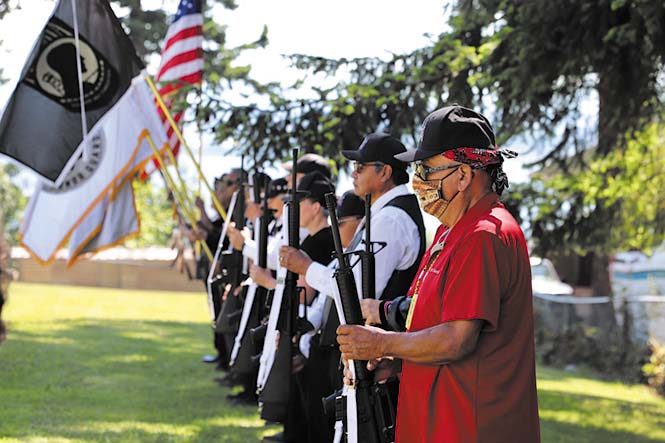
A number of veterans shared words at both ceremonies, thanking the groundskeepers for maintaining the cemeteries. The maintenance crews were credited with enhancing the beauty of both of the sites to compliment the views of the Salish Sea, and for providing an exquisite space where families can gather and remember those who have transitioned to the next journey after providing years of dedication and service to their country.
William McLean III, Tulalip Veterans Department Manager said, “I want to thank the maintenance crews, all of them. We have a few veterans that came out to clean the cemetery today. We have the regular grounds maintenance crew that cuts the grass and does pick-up, and we have building maintenance crew members – every single day they come out and put these flags up and take them down. They show their respects to each individual flag, for each branch of service and our country. I want to thank everybody that put in work this entire month to give respect.”
Tulalip elder and Marine Veteran, Cy ‘Saigon’ Williams recounted, “When I think of our people who have lost their life at war, I think of my dad. My father was Bernard Williams Sr. he fought in the South Pacific from island to island and he didn’t make it home. The next one I think of is my oldest brother, Bernard Williams Jr. he was in the United States Marine Corps, he served in 7th Engineer and he came into Vietnam in ’65. They fought their way all the way to the Ho Chi Minh trail. And I think of my youngest brother, Randy Williams, he was Naval personnel and took care of records that brought in ammo, personnel and equipment for the war. We all made it home, but I do miss my brothers now – how we used to visit as a family every weekend and share some beers and a lot of bad memories. I want to thank my people for being here to remember our fathers, grandpas, uncles, brothers, sisters who have served this Nation.”
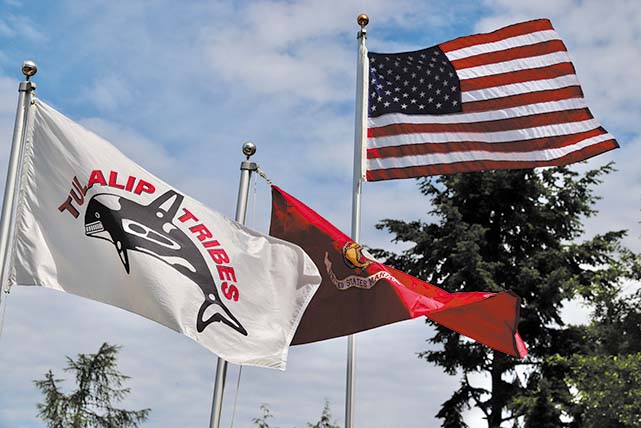
The ceremonies concluded with roll call and a 21-gun salute in honor of those who enlisted and since have passed. As the people left the Mission Beach cemetery, visiting the graves of their fallen heroes on their way out, an eagle soared high above the cemetery grounds, a symbolic gesture that many family members in attendance will undoubtedly hold dear to their hearts for years to come.
“When we went to Vietnam, there are guys I remember who became pilots [with me],” Mel shared. “Because of Operation Lam Sun 719, twelve of them did not get to come home. During my unit in Charlie Troop, I had two crew chiefs that did not get to come home. Two cobra pilots, their aircraft flew into the ground – we still don’t know why. I talked to them that morning, by noon they were gone. It is this day that I remember them in a good way, to remind us how fortunate we are. To remember too, how many Native Americans step up to the plate, especially at home here in Tulalip. If you look around, look at all the flags. We are very proud of our veterans who serve.”
A Ride to Remember
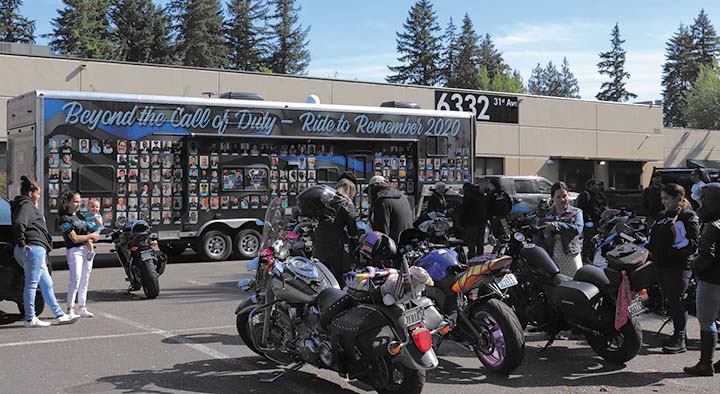
By Kalvin Valdillez, Tulalip News
Ducati’s, Harley’s and Suzuki’s revved to life on the morning of May 30. They zoomed out of the parking lot of the Tulalip Justice Center, getting set in formation behind a cohort of Tulalip Police Department (TPD) Fish and Wildlife pickup trucks, leading a giant trailer which featured the photos of 338 police officers who died in the line of duty over the past year. A warm, loving bright smile, that many Tulalip community members knew so well, and will continue to fondly reminisce of, can be spotted on the trailer, on the passenger side near the front.
A community still hurting, many Tulalip tribal members and citizens were amongst the procession of about 100 motorcycles, ATVs, police vehicles, cars, trucks and vans, rallying behind the family of Fallen TPD Officer, Charlie Cortez. It’s been over a-half-a-year since the tragic accident occurred on local waters, which claimed Charlie’s life at the young age of 29. As Charlie’s remains still have yet to be recovered, organizations and multiple police departments have reached out to his family, offering support and ensuring his legacy lives on for years to come. In the past few months, Charlie’s name has been read aloud during roll call at virtual memorial tributes and etched into marble memorial walls. Charlie recently received a posthumous award, a medal of honor for his sacrifice to his people and community.
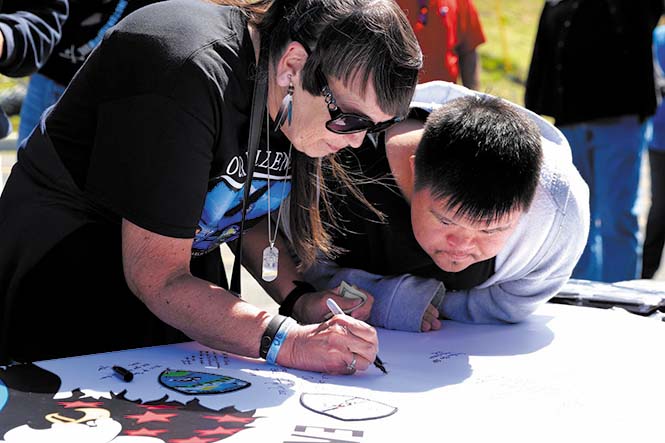
With everyone in position the motorcade was off. Sirens wailing and headlights flashing, the vehicular ensemble traveled the length of the reservation from the court house to the marina, receiving support from commuters along the way who honked, waved and pulled to the side of the road during the honoring parade.
The moving tribute to Officer Cortez is a project that spans across the Nation called End of Watch – A Ride to Remember, arranged by a non-profit known as Beyond the Call of Duty. The organization has one sole mission; to honor the legacy of all the fallen police officers throughout the country. Tulalip was just the second stop on an 84-day, 22,500-mile journey around the U.S.
“This is our second year, we have six motorcycles and we plan on keeping it going,” said Beyond the Call of Duty Founder, Jagrut ‘J.C.’ Shah. “It was something I was thinking about for a number of years, and it’s something that should be done as far as letting the Nation know versus just the state or local city. I wanted all the departments to know that we’re all together in the same boat. I wanted the survivors to know that they aren’t alone. That’s really been our mission since last year and we’re seeing it today. We we’re able to bring a survivor from 2019 to talk to the Cortez’s. He lost his son; it is difficult, but they speak the same language because we can’t express that hurt, that loss.”
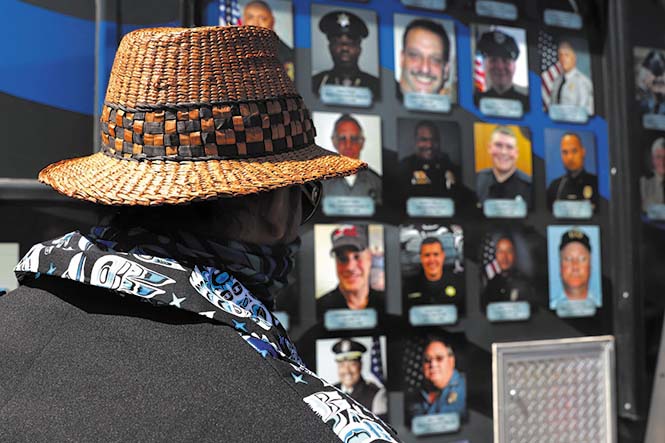
Upon arriving at the marina, a number of local leaders spoke about the Tulalip hero, about how he gave his life defending his Tribe’s treaty rights as both a Fish & Wildlife officer as well as a tribal hunter and fisherman.
“Charlie was a peacemaker, he was a loving, wonderful young man who came to work to do his duty always with a smile,” recalled TPD Chief of Police, Chris Sutter. “Charlie laid down his life for his tribe, protected treaty rights that were negotiated 150 years ago to preserve a way of life and a culture. He was out doing his duty as a fish and wildlife officer for the Tulalip Police Department and was taken in the line of duty. Charlie Joe Cortez will always be a hero in our community. Always remembered and never forgotten. We love you, we love the family.”
Said Tulalip Vice-Chairman Glen Gobin, “Charlie became a part of each and every one of you in his walk. When Charlie lost his life that day in the line of active duty, he gave it all doing what he signed up to do, with the greatest honor and respect that he had for what he believed in when he put that badge on, what he stood for – to stand up and serve his community, his people. Charlie’s birthday was yesterday, he would’ve been 30 years old today. Forever 29 in our hearts, forever 29 in our memories. In whatever way you walked in his life, whatever you shared in his life, you carry that with you.”
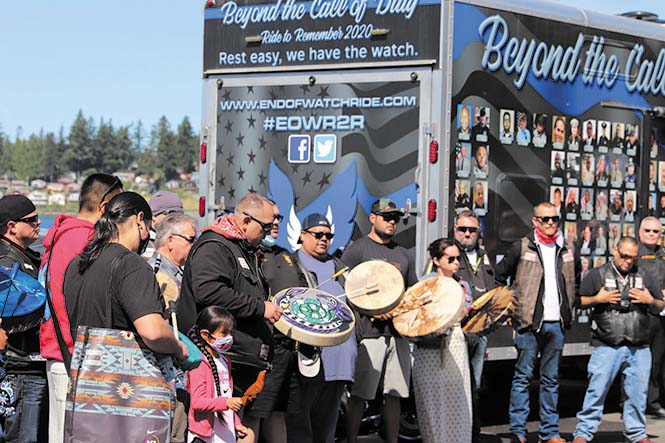
Charlie’s parents, Paula and Alan Cortez also spoke, thanking those in attendance for their continued support.
“Seeing you guys all ride in and watching the Beyond the Call of Duty memorial come in was an amazing feeling that is helping us heal,” expressed Paula while fighting back tears. “We still have yet to have our son’s service. We’ve been active as parents to let the media know that we will not give up. We have had people volunteer. Our police department, while they’re working on other fishery related matters out on the water they are keeping their eyes open. We have had people contact us who raced with him while he was in motocross and they are wanting to help, they are divers and have sonar equipment and they want to be here for us. I want to thank all the agencies that came that night on November 17, 2020, my hands go up to you, you were out there that night, the next night and beyond. I want to extend the deepest gratitude for the honor that you are giving to not only my son, but to my family, his children, our community members and the police department he served.”
Alan then took a moment to gift a hand drum to J.C., which he made from elk hide that both he and Charlie harvested together. The ceremony ended with a song and blessing from a group of Tulalip singers, many of whom rode along in the convoy; some on their ATVs and in their everyday vehicles, some a part of the Tulalip motorcycle club, the Sacred Riders, who escorted the procession throughout Tulalip.

A belated BBQ birthday celebration was planned to coincide with the End of Watch ceremony, as May 29th would’ve been Charlie’s 30th trip around the sun. While TPD officers worked the grill, the people wrote personal and heartfelt messages to Charlie on a large End of Watch banner, and took photos next to his picture on the memorial wall.
The Cortez family is determined to bring Charlie home and they believe that his return can bring some much-needed peace, healing and a closure to the Tribe, the law enforcement community and most importantly Charlie’s loved ones.
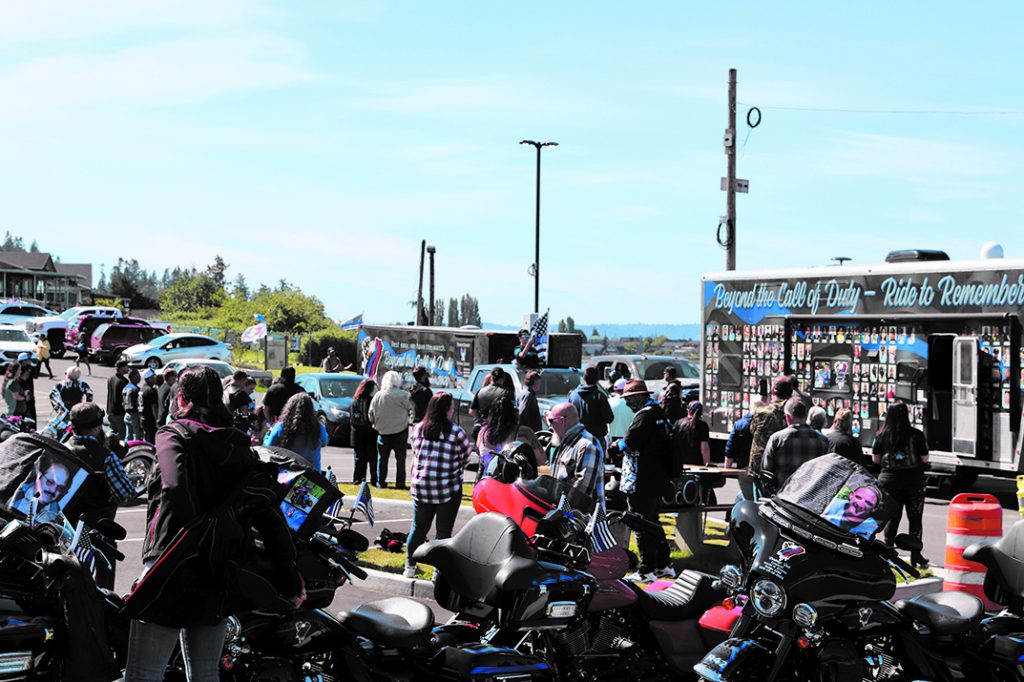
Thank you for keeping Charlie’s family and the Tulalip Police Department in your prayers. As always, please send any potential evidence, information or your own informal searches to us by texting 360-926-5059, or emailing bringofficercortezhome@gmail.com, or leaving a voicemail at (909) 294-6356.
To keep up with the traveling memorial wall as it journeys across America, please visit the Beyond the Call of Duty Facebook page for nightly video recaps and photos of each of their stops.
Covid Case Update, May 28, 2021
May 29, 2021 syəcəb
More than a carving, House of Tears story pole a reminder to protect the sacred
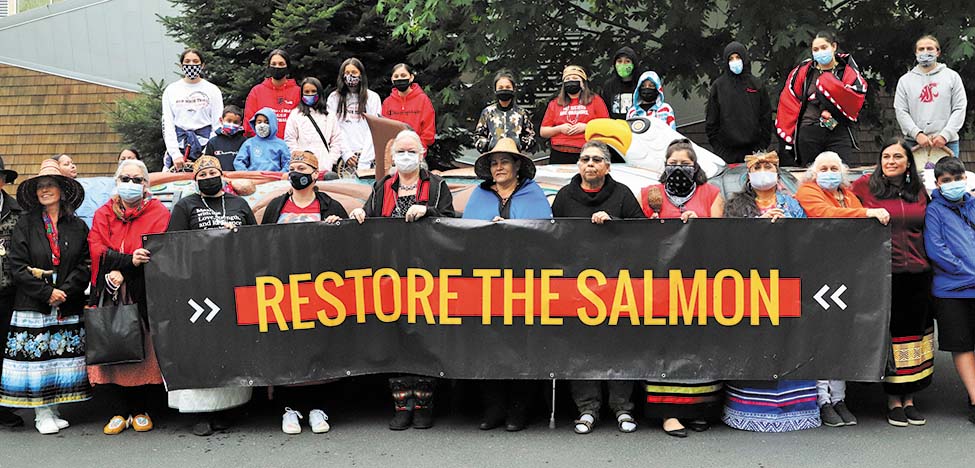
By Micheal Rios, Tulalip News
A large crowd of community members welcomed the Red Road to D.C. story pole journey during its Tulalip visit on May 17th. Designed with Indigenous precision by Lummi Nation’s House of Tears carvers, the 400-year-old western red cedar lay front and center while embodying an unwavering message to protect the sacred.
“We are all coming together, like figures in a story pole, to produce an end vision – the protection of Native American sacred sites,” explained head carver and Lummi activist, Jewell ‘Praying Wolf’ James. “Native America has endured hundreds of years of oppression, yet our spiritual practices and beliefs have not been exterminated. We are still connected to Mother Earth spiritually, and our sacred sites are extremely essential to our native belief systems.
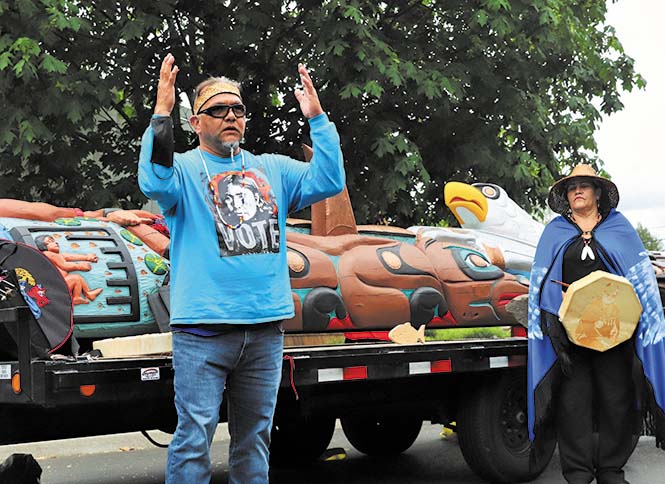
“Working on story poles opens up a path to the spirit,” he continued. “It is my hope that this pole will transmit that spirit to Washington D.C. and allow the Biden Administration to follow through on their treaty obligations. Many of us believe that the United States owes it to us to listen. They entered into a sacred relationship with us, some people call it a treaty. But they use their voices to promise. To us, when you use your voice, it takes the sacred wind and the Great Spirit gives you the energy to talk. Your verbal commitment is one of spiritual significance to Native Americans. We hope by bringing this story pole to Washington, D.C., we’ll also awaken the sacred commitment the United States has to Native American Nations.”
It took over two months and fourteen pairs of hands working in synch to transform the nearly two ton, old-growth cedar log into a symbol of our collective ancestral responsibility to protect sacred lands, waters, and wildlife for generations to come. At twenty-four feet, eight inches tall and three feet wide, it tells a story of connectedness and asks for accountability by the humans who call this planet home. Skillfully etched in the pole are a moon, a diving eagle, two Chinook salmon, a sea bear, a sea wolf, a grandmother with her grand-daughter, and a number of spiritually strengthening elements chiseled throughout.
Featured on the pole are seven tears to represent the seven generations of trauma passed on from colonialism. Also included is an image of a child in jail in reference to the U.S. – Mexico border issues and the bloodline relationship of immigrants seeking entry to the country whose lands they once occupied. No to be overlooked are the numerous blood red hands from top to bottom that symbolize the silenced voices of missing and murdered Indigenous women.
“Many grandmothers are raising their granddaughter as their daughter because the mother is missing in action,” said Jewell. “Either she got abused by a husband and ran and disappeared for her own safety or she got caught up into drugs, or she’s missing and murdered. It’s a nationwide crisis. We like to dream that we have a perfect relationship, but the fact is the United States, the State of Washington, all our tribes, the counties and cities, everybody has to enact laws to tell the men: ‘Quit beating the women! Leave the women alone. Stop it or we’ll imprison you.’ It’s sad that we have to have the law tell us it’s wrong. It’s a reflection of our attitude, and the way we treat the female in the family is how we treat the Earth. The scars are permanent.”
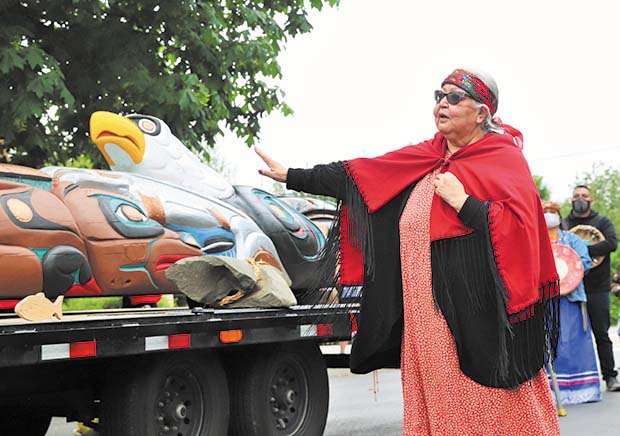
Mother Earth is covered with scars. Her air is polluted by the burning of fossil fuels, oceans filled with industrial waste, forests replaced by concrete jungles, and arctic shelf continuing to melt away because of global warming. What’s happening is a result of a perspective that sees everything as a resource to be exploited. Its killing Mother Earth and threatening life across the planet. Life, whether it be aquatic, avian or land based is suffering. Mother Earth’s creatures are dying of sickness because her life giving air and water are being poisoned.
“We look at our children and our heart aches because how do we stop the devastation of what’s happening to our mother? What are we going to leave our children when we’re dust? What kind of lifestyle are we leaving them to inherent?” pondered Lummi master carver Douglas James to the intently listening crowd. “We’re reaching out and asking for all to come together with one heart and one mind because it’s for the children and their future children that we need to be accountable. We must stand up for them now, like our ancestors once stood up for us. Or else our children can look forward to only being able to breathe fresh air through an oxygen tank and drink clear water from a plastic bottle.”
The House of Tears carvers hope to bring a moment of self-reflection across the United States and an acknowledgement of past and present injustices inflicted on Native peoples and lands without consent, as they plan to journey 16,000 miles to share the messages within their story pole. Their cross-country trip is only just beginning as they intend to visit all federally recognized tribes in Washington State before going down the Pacific coast.
They will make stops at several locations that are considered sacred to local tribes and Indigenous peoples, and are current or potential targets for dams, mining, drilling, or oil pipelines. At each stop, they will display their story pole especially created to honor these sacred sites. They will meet with local tribes and residents to underscore the message that tribes must give their consent before major infrastructure projects are approved.
“This is a spiritual gift being shared with the people, all the tribes throughout the U.S.,” said Tulalip elder Inez Bill. “I’d like to thank the carvers for including us and acknowledge our Tulalip elders who came here today to represent our people in this historical occasion. This pole serves as an example of what we can do when we unite our hearts and minds in thanks for the blessings we’ve been given. It is a blessing to be stewards of this land. The natural environment is where our spirituality and traditions come from. Our ancestors thought about their future generations and fought to have their usual and accustomed areas accounted for in the treaties. We need to honor and respect our ancestors by taking care of these areas. The way of life of our people depends on the teachings and values that were laid out for us. It is our responsibility to carry them forward.”
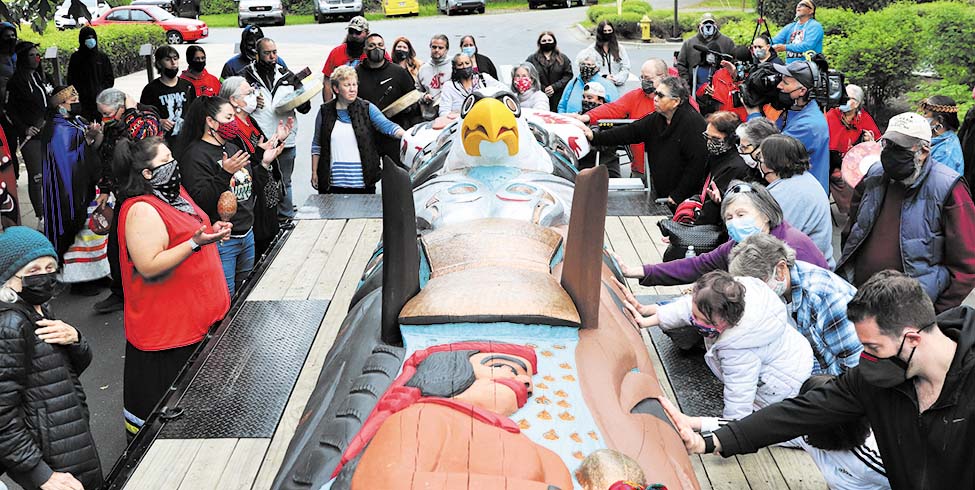
Red Road to D.C. journey stops will include sacred sites such as Bears Ears National Monument in Utah; Chaco Canyon, Navajo Reservation in New Mexico; and the Black Hills in South Dakota. Planned visits also include locations where Native-led oil pipeline protests made national headlines, like the Standing Rock Reservation in North Dakota and the White Earth Indian Reservation in Minnesota before finally arriving in Washington, DC on July 28, where the pole will be delivered to the Biden-Harris Administration. Concluding the Red Road to D.C. journey, the story pole will be enshrined as a featured monument in the Smithsonian National Museum.
The story pole journey is a project that makes visible the struggle for life. It brings awareness to the connectedness of all Mother Earth’s people and our shared history. It ties together communities who are living on the front line of the environmental emergency. It makes the commonality of their suffering visible and strengthens the bonds of solidarity between them.
As the pole travels it draws lines of connection honoring, uniting and empowering communities working to protect sacred sites. It carries the spirit of the lands it visits, and the hopes and prayers of communities along the way. As the pole travels from place to place and comes into contact with more and more people, it grows more powerful. People who touch it give it power, and it in turn gives power to them.
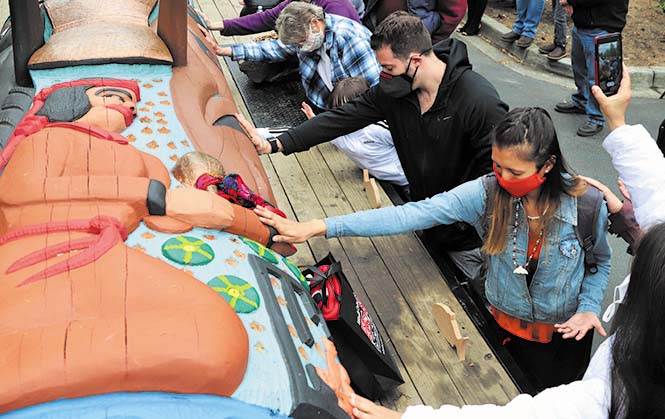
“This gathering was so special because we honored a story pole that will be traveling to D.C. to be presented to the White House. I’m thankful we were able to share our welcoming song and bless the pole in our own traditional way, with youth and elders as witnesses,” reflected Tulalip Chairwoman Teri Gobin. “This pole recognizes our relationships we’ve created with the federal government and the many broken promises we’re trying to have corrected, to make things better for our people.
“As tribes, we have been fighting much of the same fights since treaty times, and we’ve shown over and over again that when we come together we are strong,” she added. “Being able to have our people touch the pole and put their prayers into it, knowing that tribal members from all across Indian Country will do the same, is extremely powerful. It lets us know that we are in this fight together. We are fighting for our environment. We are fighting for our treaty rights. We are fighting for our future generations.”
To follow the pole’s journey and see a list of tour stops visit www.redroadtodc.org Events will be live-streamed via the group’s public Facebook page – Our Shared Responsibility: A Totem Pole Journey.
Tulalip Emergency Management hosts first American Red Cross Blood Drive
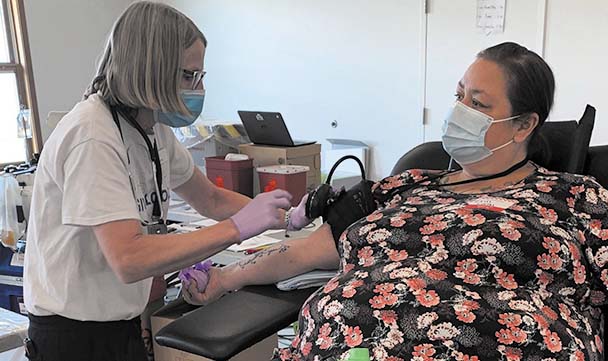
By Kalvin Valdillez, Tulalip News
“Twenty years ago, I almost died twice,” shared Erin Taylor. “I had to have blood transfusions. So, in order to give back, I’m donating blood today.”
In a partnership with the American Red Cross, the Tulalip Emergency Management department organized and hosted an all-day blood drive on May 20. While it seemed like a dark and cloudy day throughout the Northwest, it was warm weather and clear skies on the Tulalip Reservation, permitting a beautiful view of Tulalip Bay for the blood donors who were inside the Kenny Moses Building, stretched out on medical tables and squeezing stress balls for optimum blood flow.
“Blood drives are important because your donation saves lives,” expressed Vanessa Kelsey, Tulalip Emergency Preparedness Coordinator. “This is our very first American Red Cross Blood Drive, the first of many. Ashlynn (Danielson) [Emergency Preparedness Manager] is on the American Red Cross Board and that’s how we got set-up with them. When Red Cross reached out to us, we secured the building and made it happen.”
According to the American Red Cross, 4.5 million lives are saved each year by blood transfusions. The non-profit also claims that every two seconds, someone in the U.S. is in the need of blood, and just one donation can save up to three lives.
Just moments after arriving at the Kenny Moses Building to donate blood himself, Tulalip Bay Fire Department Training Captain Chris Finley stated, “In the medical world, there’s always a shortage of blood for people who need it, whether that’s little kids who have cancer or people who suffer traumas. Anything we can do to help out – absolutely, why not. I would recommend everybody who’s in good health to donate blood; hospitals are always hurting for more blood.”
The Emergency Management team had a full schedule on the day of their first blood drive. After it was all said and done, the American Red Cross reported, “last Thursday, the Tulalip Tribes collected thirty-three units of blood, saving up to 99 lives. [We] can’t tell you enough how amazing this is for a first-time drive.”
The Office of Emergency Management is planning to host more blood drives on a regular basis, with the next drive occurring on July 29th from 10:00 a.m. to 4:00 p.m. at the Tulalip Dining Hall. If you are interested in making a donation, please schedule an appointment by contacting 1-800-RED CROSS (1-800-733-2767) or visit RedCrossBlood.org and enter: TulalipTribes.
The American Red Cross also has a phone app where you can make appointments, track your personal donations and earn badges the more you donate. Vanessa and Ashlynn are calling upon anybody who is eligible to donate at the next drive. And to speed-up the process during your appointment, the team also encourages donors to fill out the American Red Cross RapidPass prior to their scheduled donation time.
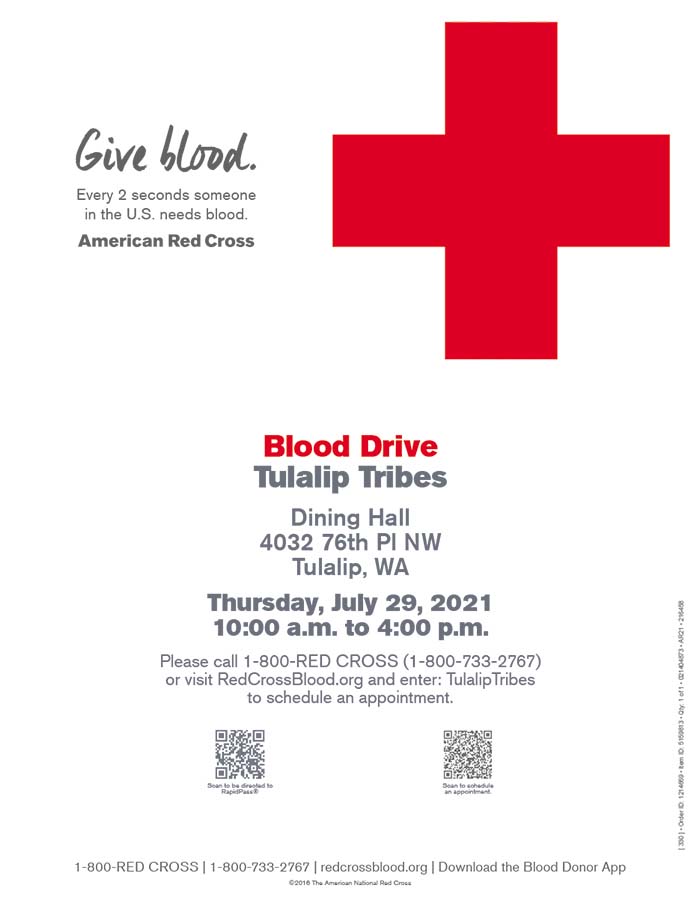
Charlie Cortez receives Medal of Honor
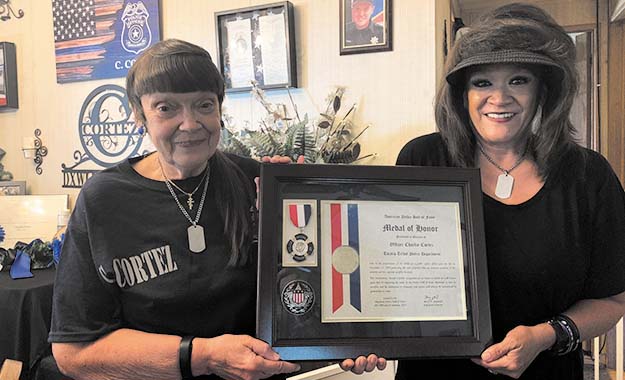
By Kalvin Valdillez, Tulalip News
As the search for fallen Tulalip Police Officer Charlie Cortez continues, the law enforcement community is taking measures to commemorate the late officer’s name for generations to come. Police agencies around the country are paying tribute to both Charlie and his family, by speaking his name at roll calls during remembrance ceremonies and vigils, as well as engraving his name into memorial walls that are dedicated to officers who paid the ultimate sacrifice while on the line of duty.
Most recently, Charlie’s family received a package from the American Police Hall of Fame, a posthumous award of the highest degree, the Medal of Honor. The medal fits perfectly on the memorial wall his loved one’s set-up at his family’s home, complete with photographs of the tribal officer, and displayed next to his many accolades.
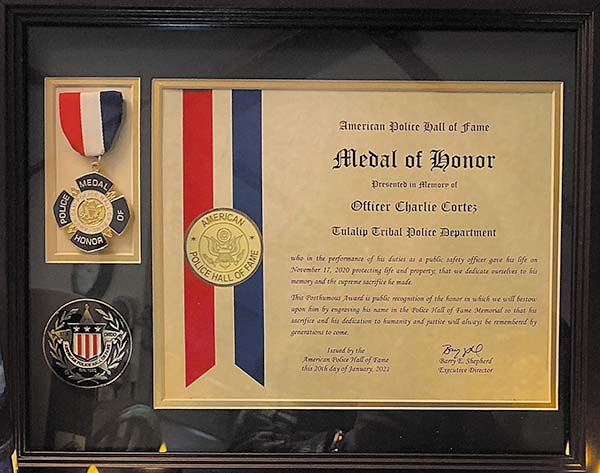
“We got a letter from the American Police Hall of Fame mentioning that his name is going to be etched into the marble at the Hall of Fame Memorial Wall with 8,000 other police officers that have fallen in the line of duty,” said Charlie’s mom, Paula Cortez. “We’re so proud of him but at the same time our hearts break that he’s no longer here with us. The law enforcement world has been phenomenal at making sure that he’s honored and that he’ll always be remembered. That’s special for our family and for his kids who will be able to go and visit those memorials. And in the future, they can share that with their kids, it’s something that will be there forever.”
At the end of the month, on May 29th, a nation-wide traveling event is coming to Tulalip to honor Charlie and all of the officers who transitioned to their next journey while protecting and serving their communities. A large trailer will make-it’s-way throughout the reservation to raise awareness and honor the officers and their families, beginning at 9:30 a.m. at the Tribal Justice Center and ending at the Tulalip Marina. The trailer is a project known as ‘Beyond the Call of Duty’ and features the photos and the names of all the fallen officers over this past year.
The Beyond the Call of Duty trailer will be accompanied by the End of Watch Motorcycle Club, which was created in memory of those officers who dedicated their life to the badge and are no longer with us. As it happens, the event takes place one day after Charlie’s birthday, so in addition to the convoy, the local police department and Charlie’s family will be throwing a BBQ celebration for the young, fallen officer at the Marina shortly after the motorcade.
Thank you for keeping Charlie’s family and the Tulalip Police Department in your prayers. As always, please send any potential evidence, information or your own informal searches to us by texting 360-926-5059, or emailing bringofficercortezhome@gmail.com, or leaving a voicemail at (909) 294-6356.
